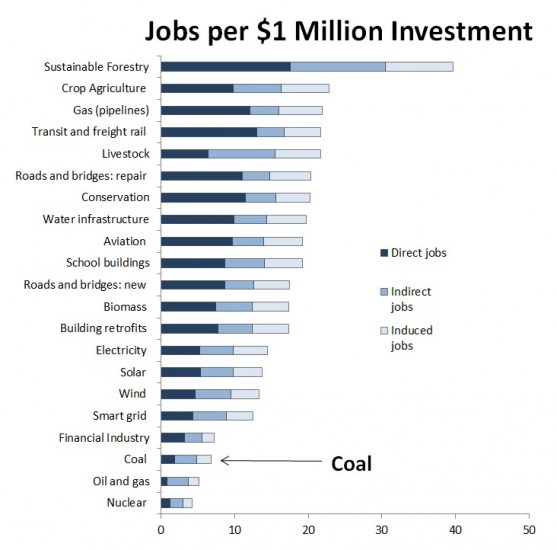Think about coal miners and you probably envision old Americana images: soot-blackened union guys with picks slung over their shoulders. But the truth is, modern-day coal mining is highly mechanized and it employs relatively few workers, many of them non-union.
Consider the coal companies in the Powder River Basin that extract nearly 500 million tons of coal each year with just 7,000 workers. That’s nearly half of all the coal mined in the US each year and it works out to roughly 66,000 tons of coal for each worker, on average. It’s an astonishing display of the industrial efficiency deployed in strip mining-like techniques. Yet it also means that coal mining is a poor strategy to create jobs.
In fact, as economists at the University of Massachusetts’ Political Economy and Research Institute have shown, it’s hard to make a worse jobs investment than coal.
Nearly any other infrastructure investment produces more jobs than coal, even when you factor in the indirect jobs and other secondary jobs. It just doesn’t stack up.
In the Powder River Basin—home to the coal planned for export to Asia via the Northwest—coal miners are overwhelmingly non-unionized.
In fact, recent employment trends are moving away from union workers.
As the Northwest debates coal export proposals—and residents sort through competing claims about jobs and economics—it’s worth bearing in mind that western coal mining is simply not, by any measure, a job-intensive industry.
Notes and sources.
Chart 1, “Jobs Per $1 Million Investment” is by Sightline Institute using data from Heidi Garrett-Peltier and Robert Pollin, University of Massachusetts Political Economy and Research Institute. (Multipliers derived using IMPLAN 2.0 with 2007 data. Infrastructure multipliers and assumptions are presented in “How Infrastructure Investments Support the U.S. Economy: Employment, Productivity and Growth,” Political Economy Research Institute, January 2009.) For the sake of brevity, I shortened several of the investment category names; the full titles can be found here.
Charts 2 and 3, “Coal Mining Employment” and “Coal Mining Employment Trends” are by Sightline Institute using data from Table 20 of the US Energy Information Administration’s “Annual Coal Report 2011” published on November 8, 2012.
Thanks to Pam MacRae for research assistance.




Comments are closed.